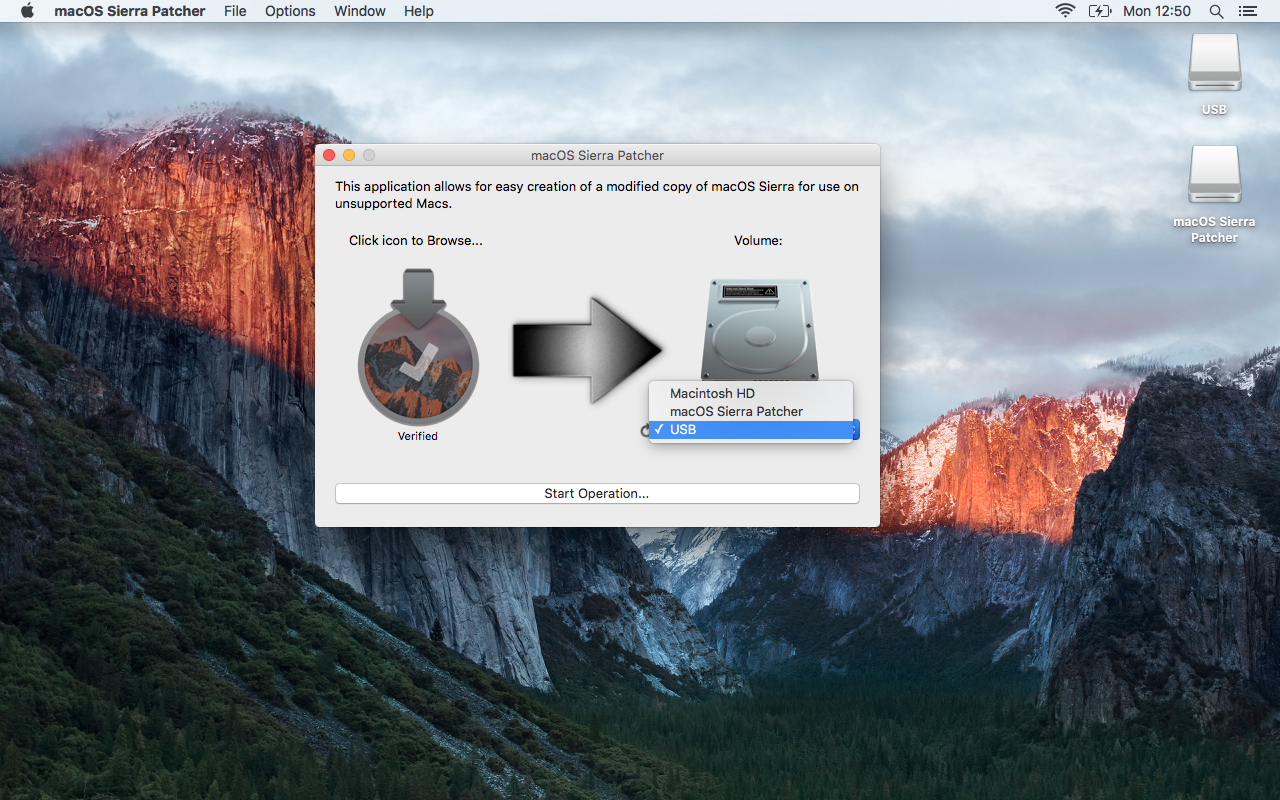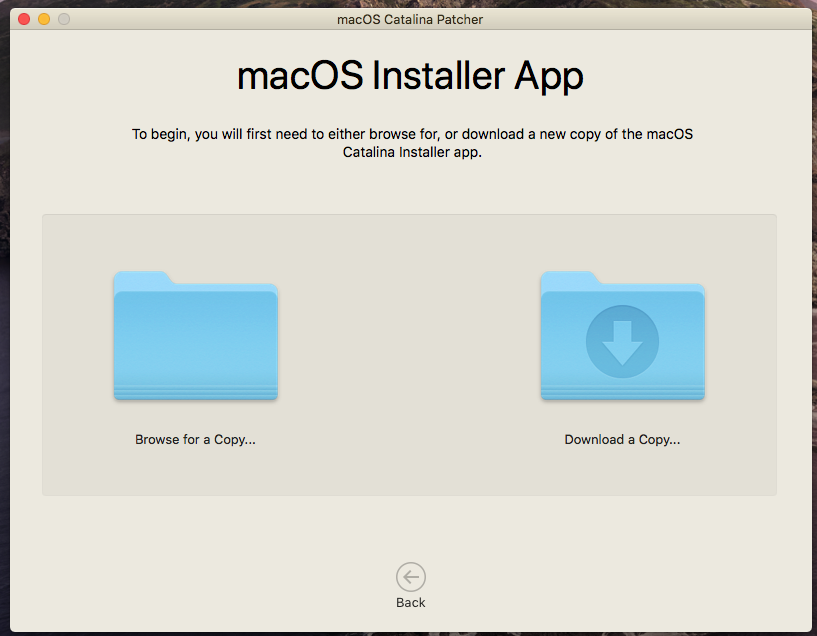Introduction
Click the Download button to download the OS X El Capitan installer. Note: It’s always a good idea to run any other updates that might be available before running the OS X update. For example, this morning my iMac had an Xcode update and a security update waiting, so I ran those with the knowledge I’d be updating to OS X El Capitan later. Mac Os El Capitan Patcher Tool For Unsupported Mac's Adventures Mac Os El Capitan Patcher Tool For Unsupported Macs. OS X 10.11 El Capitan, released on September 30, 2015, is the next iteration of OS X, building on the.

A: Check to make sure your Install macOS Sierra App is the correct one. It should be around 5GB in size. If you used the 'Skip App Verification' option, you have most likely selected an invalid app that doesn't contain the necessary files. Q: I cannot open my copy of Install macOS Sierra with the patch tool.
This project is a new and updated branch of the Yosemite tree and is targetted at OS X 10.11 El Capitan with SIP support, automatic installer detection and fake board-id injection for unsupported models of the MacPro and MacBook Pro.

Download
All downloads of boot.efi should be done from this project page. All other sources are unsupported.
Download your copy of the prebuild (32-bit) version of boot.efi for El Capitan (compiled on Microsoft Windows 10 with Microsoft Visual Studio 2015) with a black background and white Apple logo now, and verify the download by entering (either one) in a terminal window:

Or download the one for legacy hardware, with a grey background and logo for your Mac Pro and verify the download by entering (either one) in a terminal window:
Note: If the output is different, then your copy of boot.efi should not be used!
Compilation
Don't want a prebuilt copy of boot.efi then compile the source code yourself, with either Microsoft Visual Studio 2013 or 2015. The latter requires you to update the solution files, but that should be done automatically in the MS Visual Studio IDE.
Note: See also Compiling-Instructions

Thanks To
This project would not have been possible without the help of Peter Holbrook, Mike Boss and a number of other people. Peter did all compiling and Mike ran dozens of test builds that Peter pushed out over at forums.macrumors.com Awesome work guys. Job well done!
I'd also like to thank everyone else whoh helped with testing our nightly builds. Thank you so much!
Help
If you need help with the setup then please visit this macrumor thread. Developers, or people who need help with compiling boot.efi themself, can visit this macrumors developer thread.
Note: I myself don't own any unsupported Apple hardware with a 32-bit EFI implementation, so I can probably do not much for you, but there may be others to help you.
Bugs
Bugs can be reported here
Note: Please provide a clear step by step procedure to reproduce the bug. Thanks.
License
My work is licensed under the Creative Commons Attribution-NonCommercial 3.0 Unported License and as such you must add a link to this license. Even if you only use a download link. Also note the term 'NonCommercial' because I don't want to see my work end up anywhere else but here.
Note: 'Tiamo' released his work under a BSD-3-Clause license
Disclaimer
Copyright (c) 2014-2016, by Pike R. Alpha – All right reserved.
I also have a YouTube video going over the whole process.
Requirements:
- Early-2008 or newer Mac Pro, iMac, or MacBook Pro(MacPro 3,1 and 4,1, iMac 8,1 and 9,1, MacBook Pro 4,1, 5,1 5,2, 5,3,5,4, and 5,5)
- Late-2008 or newer MacBook Air or Aluminum Unibody MacBook (MacBookAir 2,1, MacBook 5,1)
- Early-2009 or newer Mac Mini or white MacBook (Macmini 3,1, MacBook 5,2)
- Early-2008 or newer Xserve (Xserve 2,1, Xserve 3,1)
Machines that ARE NOT supported:
- 2006-2007 Mac Pros, iMacs, MacBookPros, and Mac Minis (MacPro 1,1 and 2,1, iMac 4,1, 5,1, 5,2, 6,1 and7,1, MacBook Pro 1,1, 2,1, and 3,1, Macmini 1,1 and 2,1)
-- The 2007 iMac 7,1 is compatible if the CPU is upgraded to a Penryn-based Core 2 Duo, such as a T9300.
- 2006-2008 MacBooks (MacBook 1,1, 2,1 3,1 and 4,1)
- 2008 MacBook Air (MacBookAir 1,1)
-- Note: Make sure SIP is disabled on the system you intend to installHigh Sierra on. If it's not or you're unsure, just boot into your Recoverypartition of your currently installed copy of OS X, open Terminal, andrun 'csrutil disable'.
Things you'll need:
- A copy of the macOS High Sierra InstallerApp. This can be obtained from the Mac App Store using a machinethatsupports High Sierra, or by using the built-in downloading feature of the tool. In the Menu Bar, simply select 'Tools > Download macOS High Sierra.'
- A USB drive that's at least 8 GB in size
- A copy of the tool - Download here (Current version: 2.7.0, SHA1: 73f180d30200ef5f6d900440fe57b9c7d22bd6bf)
-- View changelog and download older versions here
Known issues:
- Trackpad (MacBook5,2 affected only). The trackpad in the MacBook5,2isn't fully supported in High Sierra. While it works and is fully usable,High Sierra detects it as just a standard mouse, preventing you fromchanging some trackpad-oriented settings.
How to use:
1. Insert your desired USB drive, open Disk Utility, and format it as OS X Extended (Journaled).
2. Open the 'macOS High Sierra Patcher' tool, and browse for your copy of the macOS High Sierra Installer App.
*Ensure that the tool successfully verifies the app.
3. Next, select your USB drive in the Target Volume list, and click 'Start Operation.'
4. When the operation completes, boot your target unsupported Mac offthe USB drive you just created by holding down the Option key while turning on the machine, and selecting the drive.
Note: Only perform steps 5 and 6 if you intend to do a clean install.Otherwise, you can simply skip these steps and install to your volumecontaing a previous version of OS X, and it'll do an in-place upgrade.
5. When the installer boots, open Disk Utility from the Utilities menu, or by double-clicking it in the Utilities window on the bottom left corner of the screen.
6. Select the disk or partition you want to install on, and erase it,ensuring to use either Mac OS Extended (Journaled), or APFS as the filesystem type.If formatting an entire drive, ensure GUID is selected.
-- Please note that if you use APFS, you will not have a bootable Recovery partition.
-- It is recommended that you only use APFS if the target drive is an SSD.
-- If you decide to use APFS, a custom booting method will be installed by the post-install tool, as the firmware of these unsupported machines does not natively support booting from APFS volumes. It is not quite as clean as native booting, but will not cause any issues while running High Sierra. A demo of the modified booting process can be viewed here.
7. Install macOS normally onto the desired volume.
8. When the install completes, reboot back onto the installer drive.This time, open the 'macOS Post Install' application.
9. In the application, select the Mac model you are using. The optimalpatches will be selected for you based on the model you select. You canalso select other patches of your choosing.
-- The 'i' button next to each patch will show more details about the respective patch.
10. Select the volume you have just installed macOS High Sierra on, andclick 'Patch.' When it finishes patching, click 'Reboot'. It may sitthere for a few moments rebuilding caches before rebooting.
-- If for somereason the system fails to work correctly after rebooting, boot backinto your installer drive, run the post install patch again, and select'Force Cache Rebuild' before rebooting. This isn't necessary under mostcircumstances.
11. When it reboots, it should now boot into a fully working copy ofmacOS High Sierra.
Additional Info:
- If selected in the macOS Post Install tool, your High Sierra install will have a program named 'Patch Updater' located in your /Applications/Utilities folder. This program will alert you when new updates to patches are available for your machine, and will prompt you to install them. If you do not have Patch Updater installed, but would like it, you can download and run the script found here to do so.
Updates
System updates, such as 10.13.1, should install normally if 'Software Update Patch' was selected in the macOS Post Install tool, or installed using the Patch Updater program. If for some reason updates aren't showing up, or you did not apply the patch, you can install it manually using the script found here.
-- If the machine does not start up properly after applying a system update, you will need to boot off your patched installer volume, and re-run the post-install patch on your High Sierra volume. Ensure you select 'Force Cache Rebuild' before rebooting.
FAQ:
Q: The tool created the USB drive successfully, but when booting, the progress bar hangs a bit more than half way.
A: Check your copy of the Install macOS High Sierra App. If you're using thelatest version of the tool, you must be using the latest version of theInstall macOS High Sierra App. Version 1.1 ofthe patch tool and older support older versions of the installer app.
Q: The patch tool gives me errors, such as 'Error copying files.'.
A: Check to make sure your USB drive is writeable. Try re-formatting it, or just try a different USB drive.
Q: The patch tool gives me a 'Mounting Failed' error
A: Check to make sure your Install macOS High Sierra App is the correct one.It should be around 5GB in size. If you used the 'Skip AppVerification' option, you have most likely selected an invalid app thatdoesn't contain the necessary files.
Q: I cannot open my copy of Install macOS High Sierra with the patch tool.
A: If you downloaded the copy linked above, it is distributed inside aDMG file. You must open this file (mount it) to access the InstallmacOS High Sierra App you need to select.
Q: I don't see my hard drive partition in the installer screen or in the post-install tool.
A: Make sure FileVault is disabled, or use the instructions found here to unlock it manually using Terminal.
Q: I get a 'NO' symbol when starting up after successfully installing High Sierra.
A: Make sure you have run the post-install patch on the correct volume, as detailed above in steps 8-10.
Q: I get a 'NO' symbol when starting up from the patched USB drive
A: Check the supported/not supported list at the top of this page. Ensure your machine is in the supported list.
Q: My iSight camera doesn't work after installing High Sierra
A: Make sure you properly remove (using the program's uninstaller, not by simply dragging the application to the Trash) all virtual machine software installed on your machine, such as VirtualBox, VMWare, etc.
Q: I get 'NSURL' errors when trying to update my machine or use the App Store
A: This is usually the result of having an invalid CatalogURL set. To revert to stock, simply run 'sudo softwareupdate --clear-catalog' in Terminal, and then run the software update patch script located above.
Q: Safari, App Store, and/or Mail stopped working after installing a system update
A: Download and run the Onyx application, select 'Maintenence' at the top, then click the Run button.
Q: I get a 'No packages were eligible for install' error when attepting to install High Sierra
A: This is due to your system's date and time being set incorrectly. To fix it, you can either boot into your current OS X install and set the date, or you can use Terminal after booting from your patched USB installer drive to set the date. Instructions to set the date using Terminal can be found here.
Www.ringocatnote.com ※2017年5月20日 記事を加筆修正いたしました。 古いMacでは「macOS Sierra」からサポート対象外となったものがあり、ワタシのMac「iMac Early 2008」も、今回の「macOS Sierra」からサポート対象外となってしまいました。 しかし、そんなサポート対象外となってしまったMacにも、macOS Sierra. Aug 04, 2018 MacOS High Sierra added a new amazing Lock option. It is the now quiet way to lock your Mac of you is going away from your Mac for few minutes for certain purpose. So it may increase your knowledge that you have a new opportunity to set your default built-in Safari browser into reader mode. Use dmg files in windows. On reader-mode Safari only shows article and neglect.
Mac OS X Lion 10.7.2 dmg for mac free download full version. Mac OS X Lion 10.7.2 offline installer complete setup for mac OS with direct link.
Description Mac OS X Lion 10.7.2 Dmg For Mac + Overview
Among exclusive mac OS x releases, mac OS x lion is a broadly used running system. Supplying stability, safety and better compatibility features. With icloud guide, the users can effortlessly synchronize information and get several cloud capabilities. Store records at the cloud and get immediate access to the content from anywhere.
Os X El Capitan Patcher Download Pc
A sleeker and interactive consumer interface gives extra comfort to the customers to perform every day tasks. additionally, various enhancements inside the OS makes it a higher environment than the preceding release. the icloud is able to keep the contacts, emails, calendars, bookmarks and other facts. furthermore, it provides a far flung get entry to to the mac from another mac using the net so the users can get get entry to to the statistics from anywhere are nicely as easily share the facts while needed. You can also download MacOS Mojave 10.14 DMG.
Os X El Capitan Patcher Download Windows
Mac OS X Lion 10.7.2 Features Full Version for Mac OS X
Mac Os El Capitan Download
Os X El Capitan Download
Some interesting features of Mac OS X Lion 10.7.2 listed below that you experienced after download dmg of Mac OSX Lion 10.7.2 for mac.
- Provides latest iCloud features
- Wirelessly store the content to the cloud and get instant access
- emotely lock the MAC or wipe the data
- Drag the files between the desktop spaces and apps
- Active Directory Integration improvements
- Powerful and stable Mac OS X release
Mac OS X Lion 10.7.2 Dmg Setup Details
- Product: Mac_OS_X_Lion_10.7.2.dmg Mac
- Size of App: 3.5 GB
- Dmg Version: 10.7.2
- Setup Extension: dmg
- Tools for dmg needed: None
- Official Site: Apple
System Requirements of Mac OS X Lion 10.7.2 for Mac OS X
Mac Os X El Capitan Dmg
Must read listed system requirement for your Apple mac book before download this app.
- Operating System: OS X 10.5 or later
- Ram (Memory): 2 GB Minimum required for this dmg.
- Disk Space: 7 GB free space needed for this app.
- System Processor: Intel Core 2 Duo or later (Core i3, Core i5).
El Capitan Dmg File Download
Download Free Mac OS X Lion 10.7.2 Mac Dmg
El Capitan Os X Download
Click on the button below to start downloading Mac OS X Lion 10.7.2 for mac OS X. We are here to provide to clean and fast download for MacOS X Lion 10.7.2 dmg. This link is resume able within 24 hours. Keep visiting themacgo the world of dmgs.